In my previous post (see link above), I wanted to know how to combine columns that have the same data and change the column name to reflect the range. I started with a function that produced

and the accepted answer produced my desired output

I applied that same function
library(dplyr)
library(flextable)
library(stringr)
library(tidyverse)
Shop_fcn <- function(data){
data %>%
group_by(Day) %>%
mutate(N_nam = n_distinct(Names)) %>%
group_by(Names, Day, N_nam, Store, Item) %>%
summarize(n_item = n()) %>%
group_by(Day, N_nam, Store, Item) %>%
summarize(n_nam = n(),
n_item = sum(n_item))%>%
mutate(pct = round(n_nam/N_nam*100,digits = 1),
txt = paste0( n_nam, " (", pct, "%)"),
Day_n = (paste0("Day ", Day," (N=", N_nam, ")")))%>%
ungroup %>%
select(Day_n , Store, Item, txt) %>%
group_by(Store, Item, txt) %>%
summarise(Day_n = if(n() > 1)
sprintf('Day %s %s', paste(range(readr::parse_number(unique(Day_n))),
collapse=' - '),
str_remove(first(Day_n), '^[^(]+')) else Day_n) %>%
pivot_wider(values_from = txt, names_from = Day_n) %>%
mutate_at(vars(starts_with(c("Day"))), ~if_else(is.na(.), "", .)) %>%
arrange(Store, Item) %>%
group_by(store2 = Store) %>%
mutate(Store = if_else(row_number() != 1, "", Store))%>%
ungroup() %>%
select(Store, Item, str_sort(names(.)[-(1:2)], numeric = TRUE), -store2)
}
to a larger data set
Names <- as.character(c('Adam','Morticia','Morticia','Morticia','Morticia','Morticia','Morticia','Morticia',
'Morticia','Morticia','Morticia','Morticia','Mickey','Minnie','Minnie','Minnie','Minnie','Minnie',
'Lucy', 'Lucy','Lucy','Morticia','Morticia','Morticia','Adam','Gomez','Olive','Olive','Olive',
'Ricky','Morticia','Adam','Eve','Ricky','Morticia','Morticia','Minnie','Adam','Lucy','Ricky',
'Ricky','Ricky','Ricky','Ricky','Minnie','Adam','Adam', 'Morticia', 'Adam', 'Adam', 'Adam', 'Adam',
'Adam','Lucy','Olive','Eve','Gomez','Morticia','Mickey','Olive'))
Day <- as.numeric(c(1,1,2,3,6,8,9,10,11,12,13,14,1,1,2,5,6,14,1,1,14,4,4,4,2,1,1,1,14,1,5,2,
1,1,4,5,3,2,1,1,14,14,14,14,4,2,2,4,2,2,2,2,14,1,1,14,14,7,14,1))
Store <- as.character(c('None','None','None','None','None','None','None','None','None','None',
'None','None','None','None','None','None','None','None','ACE','ACE','ACE','ACE','Amazon','Amazon',
'Best Buy','CVS','Hobby Lobby','Hobby Lobby','Hobby Lobby','Home Depot','Home Depot',
'Ikea','Ikea','Ikea','Ikea','Ikea','Ikea','Lowes','Lowes','Petco','Petco','Petco','Petco',
'Petco','Petco','Target','Target','Target','Walgreens','Walgreens','Walgreens','Walgreens',
'Walgreens','Walgreens','Walgreens','Walmart','Walgreens','Walgreens','Walgreens','Walgreens'))
Item <- as.character(c('None','None','None','None','None','None','None','None','None','None','None','None',
'None','None', 'None','None','None','None', 'Hammer','Nails','Plywood', 'Bricks','Frame','Batteries','TV','Advil',
'Brush','Paint','Paint','Level','Wrench','Pillow', 'Blanket','Lamp','Vase','Table','Chair','Screwdriver','Plunger','Cat food',
'Cat litter','Goldfish','Dog food','Dog treat','Hamster','Rug','Vacuum',
'Gloves','Tylenol','Napkins','Benadryl','Soap','Soap','Shampoo','Conditioner','Lotion',
'Lotion','Foil','Lotion','Foil'))
Shop_list <- as.data.frame(cbind(Names, Day, Store, Item), stringsAsFactors=FALSE)
Shop_day<- Shop_list %>%
bind_rows() %>%
Shop_fcn ()
flextable(Shop_day)
Days 1- 14 and Days 3 - 5 should not have been combined
Applying my original function gets me closer to my desired output,
Shop_fcn <- function(data){
data %>%
group_by(Day) %>%
mutate(N_nam = n_distinct(Names)) %>%
group_by(Names, Day, N_nam, Store, Item) %>%
summarize(n_item = n()) %>%
group_by(Day, N_nam, Store, Item) %>%
summarize(n_nam = n(),
n_item = sum(n_item))%>%
mutate(pct = round(n_nam/N_nam*100,digits = 1),
txt = paste0( n_nam, " (", pct, "%)"),
Day_n = (paste0("Day ", Day," (N=", N_nam, ")")))%>%
ungroup %>% select(Day_n , Store, Item, txt) %>%
pivot_wider(values_from = txt, names_from = Day_n) %>%
mutate_at(vars(starts_with(c("Day"))), ~if_else(is.na(.), "", .)) %>%
arrange(Store, Item) %>%
group_by(store2 = Store) %>%
mutate(Store = if_else(row_number() != 1, "", Store))%>%
ungroup() %>% select(-store2)
}
Shop_day<- Shop_list %>%
bind_rows() %>%
Shop_fcn ()
flextable(Shop_day)
 however, I'm now stuck with the same problem of combining identical days (specifically, columns Days 8-13) and the new issue of the Days not being ordered 1-14.
however, I'm now stuck with the same problem of combining identical days (specifically, columns Days 8-13) and the new issue of the Days not being ordered 1-14.
I'm not sure if the best solution would be to modify the function, or to apply a new function to the flextable to combine columns and the respective column names.
I tried to remove the duplicate columns, but still couldn't come up with a solution on how to preserve the names of the duplicated columns appear as a range or how to get the columns in the proper order.
Shop_nodup <- Shop_day[!duplicated(as.list(Shop_day))]
flextable(Shop_nodup)



